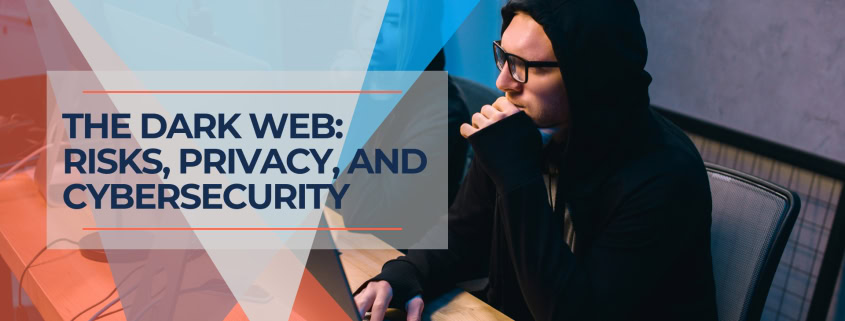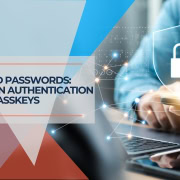Navigating the Dark Web: Cybersecurity Essentials
The internet is a vast network, yet most users interact with only a small part of it. Beyond the websites indexed by search engines lies the dark web, a portion of the internet that requires specialized software to access. The dark web has drawn considerable attention recently, particularly in cybersecurity and online privacy.
The dark web is a subset of the deep web, which includes all areas of the internet not indexed by search engines. While the deep web contains many routine sites like email accounts and databases, the dark web is intentionally hidden and often associated with anonymity and privacy. Understanding the dark web is increasingly important for both businesses and individuals, as it plays a role in cybersecurity—ranging from potential data breaches to the development of emerging online threats.
This article provides a clear, factual overview of the dark web, its uses, and its implications for cybersecurity. We will explore how it functions, examine its legitimate and illegitimate uses, and discuss its impact on cybersecurity practices.
Table of Contents
- 1 What is the Dark Web?
- 2 Dark Web vs. Deep Web
- 3 Legitimate Uses of the Dark Web
- 4 Cybercrime on the Dark Web
- 5 Cybersecurity Implications
- 6 Combating Dark Web Cybercrime
- 7 Case Studies: Law Enforcement Successes
- 8 Policy and Legal Frameworks
- 9 Practical Advice for Individuals
- 10 The Future of Dark Web Cybercrime
- 11 Conclusion
Key Takeaways
| Topic | Key Insights |
| Dark Web vs. Deep Web | The dark web is a small, intentionally hidden subset of the deep web, which requires special tools like Tor to access. The deep web includes all unindexed parts of the internet. |
| Legitimate Uses | The dark web is used for secure communication, whistleblowing, and circumventing censorship, highlighting its role in privacy protection and advocacy. |
| Cybercrime Challenges | Despite legitimate uses, the dark web hosts illegal marketplaces, making it a hub for cybercrime like stolen data sales, drug trafficking, and more. |
| Cybersecurity Measures | Effective cybersecurity strategies include multi-factor authentication, employee education, dark web monitoring, and leveraging AI for proactive threat detection. |
| Future Trends | Emerging threats like Ransomware 2.0 and identity-based attacks demand advanced countermeasures, including AI-driven defenses and stronger identity protection protocols. |
What is the Dark Web?
The dark web is a hidden part of the internet, inaccessible through standard web browsers. It is characterized by its focus on anonymity, encryption, and concealed IP addresses. The most common tool used to access the dark web is The Onion Router (Tor), which employs onion routing to ensure anonymity. Tor encrypts traffic and routes it through a network of global relays, making it difficult to trace.
The U.S. Naval Research Laboratory originally developed the dark web in the mid-1990s to enable secure communication for intelligence operatives. It was later made available to the public to promote free speech, privacy, and civil liberties.
Dark Web vs. Deep Web
The terms “dark web” and “deep web” are often used interchangeably, but they refer to different parts of the internet:
| Dark Web | Deep Web |
|---|---|
| Intentionally hidden | Not indexed by search engines |
| Requires special software | Includes password-protected sites |
| A small subset of the deep web | Encompasses private networks and databases |
Legitimate Uses of the Dark Web
The dark web serves several legitimate purposes, emphasizing the importance of anonymity and privacy.
- Secure Communication for Journalists and Activists: The dark web enables journalists and activists to communicate securely with sources, organize without fear of surveillance, and share information safely.
- Whistleblower Platforms: Whistleblowers use the dark web to leak sensitive information anonymously. Many news organizations maintain anonymous drop boxes for this purpose.
- Academic Research: Scholars use the dark web to study online behavior, communication patterns, underground markets, and cybersecurity threats.
- Circumventing Censorship: In countries with strict internet censorship, the dark web provides access to blocked websites, independent journalism, and forums for political dissent.
- Corporate Use: Some organizations use the dark web to gather intelligence on potential cyber threats, protect sensitive communications, or conduct anonymous research.
- Personal Privacy: Privacy-conscious individuals use the dark web to browse anonymously, protect personal data, and access services without revealing their identity.
Cybercrime on the Dark Web
While the dark web has legitimate uses, it is also home to various forms of criminal activity. Cybercriminals exploit its anonymity to facilitate illegal activities such as selling stolen information, ransomware distribution, drug trafficking, and counterfeit goods. These activities present significant challenges for law enforcement and cybersecurity professionals alike.
Recent advances in machine learning and artificial intelligence have improved the ability to track and link users across dark web forums. MIT's Lincoln Laboratory researchers have developed algorithms to link personas across different forums by analyzing user activity, communication patterns, and network connections, with a reported accuracy of 95%. These innovations are helping law enforcement agencies better understand the connections between dark web users and combat illicit activities more effectively.
Dark web marketplaces function similarly to legitimate e-commerce platforms, with user reviews, escrow services, and customer support. However, they deal in illegal goods, making them a concern for businesses and individuals due to risks such as data breaches, identity theft, and corporate espionage.
Cybersecurity Implications
Criminal activity on the dark web has significant implications for cybersecurity. Businesses face threats like data breaches, financial loss, and reputation damage, while individuals risk identity theft and financial fraud.
Proactive cybersecurity measures are essential to protect against these threats. Organizations should implement strong, unique passwords, use multi-factor authentication, monitor for data breaches, educate employees, and employ dark web monitoring services to detect potential risks. See our Cybersecurity for Remote Workers: Your 2024 Guide for more specific strategies for securing remote work environments. These steps can help mitigate the risks posed by the dark web.
Emerging technologies like artificial intelligence and machine learning also play a key role in improving cybersecurity practices. These technologies analyze vast amounts of data to identify patterns that could indicate cyber threats originating from the dark web. For small businesses looking to enhance their security posture, see our Small Business Cybersecurity: Your 2024 Playbook. CrowdStrike's 2024 Global Threat Report highlights how leveraging AI has significantly improved threat detection and response capabilities across multiple industries.
Combating Dark Web Cybercrime
Efforts to combat cybercrime on the dark web involve a combination of law enforcement initiatives, technological solutions, and cybersecurity best practices.
- Law Enforcement Efforts: Agencies worldwide have made strides in infiltrating and dismantling major dark web marketplaces. International cooperation, sophisticated undercover operations, and advanced digital forensics are crucial for success. The Memex program, developed by DARPA, has provided tools that help law enforcement screen for human trafficking and identify other criminal activities, significantly improving investigative capabilities.
- Dark Web Monitoring Services: Organizations employ dark web monitoring to scan forums and marketplaces for stolen credentials or discussions of planned attacks, enabling them to respond quickly.
- Employee Education: Educating employees on recognizing phishing, practicing good password hygiene, and understanding dark web risks can significantly enhance an organization's security. For more insights on securing cloud infrastructure, refer to our Cloud Data Security 2024: Your Essential Guide.
- Technological Solutions: Advanced technologies, such as artificial intelligence and machine learning, are being used to detect and prevent dark web-related threats by analyzing patterns and identifying potential risks.
Case Studies: Law Enforcement Successes
Including real-world examples of successful law enforcement operations helps illustrate the efforts to tackle dark web cybercrime.
- Silk Road Takedown: One of the most high-profile operations was the shutdown of Silk Road, a notorious dark web marketplace that facilitated the sale of illegal drugs, weapons, and other contraband. In 2013, the FBI arrested its founder, Ross Ulbricht, and seized the website, dealing a significant blow to dark web commerce.
- Operation Bayonet: This joint operation between international law enforcement agencies resulted in the takedown of AlphaBay and Hansa, two major dark web marketplaces, in 2017. The operation was notable for the level of international cooperation involved and significantly disrupted illegal trade on the dark web.
- DarkMarket Shutdown: In early 2021, Europol coordinated the takedown of DarkMarket, one of the largest illegal trading platforms on the dark web, leading to the arrest of its operator. This operation underscored the growing capacity of law enforcement to tackle sophisticated cybercriminal networks.
Policy and Legal Frameworks
Effective policy and legal frameworks are vital in addressing dark web activities. Governments worldwide have worked on regulatory frameworks that strengthen law enforcement capabilities and foster international cooperation.
- Budapest Convention on Cybercrime is the first international treaty to address internet and computer crime by harmonizing national laws, improving investigative techniques, and increasing cooperation among nations. It plays a significant role in providing a structured response to dark web crimes.
- European Union Initiatives: The EU has been proactive in establishing regulations that empower member states to combat cybercrime effectively. For instance, the European Cybercrime Centre (EC3) supports member states to dismantle criminal enterprises operating on the dark web.
Practical Advice for Individuals
To enhance personal cybersecurity and avoid becoming a victim of dark web-related threats, individuals should consider these practical steps:
- Use Strong, Unique Passwords: A password manager can help generate and store strong, unique passwords for each online account, reducing the risk of credential theft.
- Enable Multi-Factor Authentication (MFA): Enabling MFA adds a layer of security, making it harder for attackers to access accounts even if they have the password.
- Monitor Personal Data: Services that offer dark web monitoring can alert individuals if their data, such as email addresses or passwords, appear in dark web marketplaces.
- Beware of Phishing: Be cautious of unsolicited emails or messages. Verify the sender before clicking on links or downloading attachments, as phishing remains a standard method for gaining access to personal information.
- Regular Software Updates: Keeping software up to date ensures that security vulnerabilities are patched, making it more difficult for cybercriminals to exploit these weaknesses.
- Network Security: Ensure your network infrastructure is secure. Check out our Essential Network Cabling Checklist for 2024 to understand how proper cabling and network setup can protect against physical threats.
The Future of Dark Web Cybercrime
The landscape of dark web cybercrime is constantly evolving, with emerging technologies and new threats. Ransomware 2.0, for instance, has become a significant concern. Unlike earlier forms of ransomware, which primarily encrypt data, Ransomware 2.0 involves more sophisticated attacks that leverage stolen data for additional extortion. Attackers are also increasingly focusing on exploiting cloud vulnerabilities and adopting Ransomware-as-a-Service (RaaS). This model mimics legitimate software services, providing tools for cybercriminals with minimal technical expertise to carry out attacks.
A better understanding of the dark web economy's supply-and-demand chains will help researchers develop technologies to disrupt them, raising the risks associated with participating in illicit activities.
Additionally, identity-based attacks have surged in prevalence. These attacks exploit personal and organizational identities through sophisticated tactics like phishing, SIM-swapping, and API key misuse. Protecting against such threats requires a layered approach that includes strengthened multi-factor authentication, continuous monitoring, and comprehensive identity access management.
Conclusion
Understanding the dark web and its complexities is crucial for individuals and organizations. While the dark web serves legitimate purposes, such as promoting privacy and providing a platform for free speech, it also harbors significant cybercrime activities. Recognizing both its positive and negative aspects helps us develop more effective cybersecurity strategies.
Individuals can enhance their safety by adopting strong cybersecurity practices, including using multi-factor authentication, monitoring personal data, and staying informed about emerging threats. Organizations must proactively secure their systems, educate employees, and leverage advanced technologies like AI to avoid potential threats.
By remaining vigilant and taking a proactive approach, we can better protect our privacy and minimize the risks associated with the dark web. Collaboration between law enforcement, regulatory bodies, businesses, and individuals will be key to ensuring a safer online environment for all.











Leave a Reply
Want to join the discussion?Feel free to contribute!